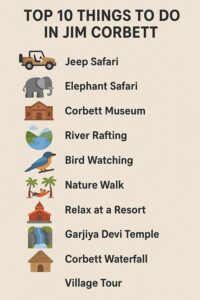Nestled in the scenic foothills of the Himalayas in Uttarakhand, Jim Corbett National Park is one of the best wildlife destinations in India. Known for its rich biodiversity and stunning landscapes, Corbett is a must-visit for nature lovers, wildlife photographers, and adventure seekers. It holds the distinction of being India’s oldest national park, established in 1936, and is a vital part of the Project Tiger initiative, aimed at protecting the endangered Royal Bengal Tiger.
Spread across over 500 square kilometers, the park is home to a wide variety of animals, birds, and reptiles. Whether you’re exploring the forest on a jeep safari, enjoying a canter ride, or taking a peaceful nature walk, every moment in Corbett offers a chance to witness wildlife in its natural habitat.
In this blog, we’ll take you through the top 10 animals you can spot in Jim Corbett National Park, making your visit even more exciting and memorable.
1. Royal Bengal Tiger
The Royal Bengal Tiger is not just the most majestic predator in Jim Corbett National Park it’s also the park’s most iconic and sought-after resident. As the flagship species of the Project Tiger initiative launched in 1973, the Bengal tiger symbolizes India’s commitment to wildlife conservation.
Species Profile
- Scientific Name: Panthera tigris tigris
- Status: Endangered (IUCN Red List)
- Habitat: Dense forests, grasslands, and riverine belts
- Diet: Carnivorous – primarily deer, wild boar, and other ungulates
Where to Spot Them in Corbett
The best zones for tiger sightings in Jim Corbett are:
- Dhikala Zone – Known for its open grasslands and high prey density
- Bijrani Zone – Offers a mix of dense forest and open areas
- Jhirna Zone – Open year-round and known for occasional sightings
Safari guides often rely on alarm calls from deer and monkeys to track tiger movements. Early morning and late afternoon safaris offer the best chances of spotting one.
Behavior & Traits
- Tigers are solitary animals and mark their territory with scent and scratch marks.
- They are excellent swimmers and often cool off in rivers and waterholes.
- Each tiger has a unique stripe pattern, much like human fingerprints.
Photography Tips
- Use a zoom lens (200mm or more) to capture distant shots.
- Be patient and quiet tiger sightings often require time and luck.
- Early morning light offers the best natural lighting for wildlife photography.
Conservation Importance
The presence of tigers indicates a healthy ecosystem. Protecting them helps conserve hundreds of other species that share their habitat. Jim Corbett’s success in tiger conservation has made it a model for other reserves across India.
2. Asian Elephant
The Asian Elephant is one of the most amazing animals you can see in Jim Corbett National Park. These large, gentle creatures are known for their intelligence, strong social bonds, and peaceful nature.
Where You’ll See Them
Asian elephants are often seen in herds, especially near rivers, grasslands, and forest trails. Early mornings and late afternoons are the best times to spot them during safaris.
Smart and Social
- Elephants live in family groups, led by the oldest female, called the matriarch.
- They use their trunks to eat, drink, play, and even show affection.
- Elephants are known to remember paths and water sources, showing how smart they are.
What They Eat
Asian elephants are herbivores, meaning they eat only plants. Their diet includes.
- Grass
- Leaves
- Fruits
- Bark
They spend most of their day eating and can consume up to 150 kg of food daily.
Fun Facts
- Baby elephants are called calves and are very playful.
- Elephants love water and often take mud baths to cool down and protect their skin.
- Their large ears help them stay cool in the hot weather.
Why They Matter
Asian elephants play a big role in keeping the forest healthy. As they move and eat, they help spread seeds and create paths for other animals.
3. Leopard
The leopard is one of the most elusive and fascinating animals in Jim Corbett National Park. Known for its stealth, strength, and adaptability, the leopard adds an element of mystery and excitement to every safari.
Where to Spot Them
Leopards prefer dense forests, rocky hills, and areas with thick vegetation. They are harder to spot than tigers because they are nocturnal and extremely good at hiding. Zones like Dhela, Jhirna, and Bijrani have reported occasional sightings.
Species Profile
- Scientific Name: Panthera pardus
- Status: Vulnerable (IUCN Red List)
- Habitat: Forests, grasslands, and hilly terrain
- Diet: Carnivorous feeds on deer, monkeys, birds, and smaller mammals
Behavior & Traits
- Leopards are solitary hunters and mostly active at night.
- They are excellent climbers and often drag their prey up trees to avoid scavengers.
- Their spotted coat provides perfect camouflage in the forest.
Photography Tips
- Use a long zoom lens and stay alert during safaris.
- Look for movement in trees or rocky areas.
- Early morning safaris offer better chances, especially in quieter zones.
Conservation Importance
Leopards play a key role in maintaining the balance of the ecosystem by controlling prey populations. Protecting their habitat helps preserve biodiversity in the region.
4. Sloth Bear
The Sloth Bear is one of the more unusual and fascinating animals you might spot in Jim Corbett National Park. With its shaggy black coat, long snout, and slow, lumbering walk, this bear looks quite different from other bear species and has a personality all its own.
Where to Spot Them
Sloth bears are shy and mostly nocturnal, which means they are active at night and rest during the day. However, lucky visitors may spot them in the early morning or late evening, especially in Jhirna and Dhela zones, where sightings are more common.
Species Profile
- Scientific Name: Melursus ursinus
- Status: Vulnerable (IUCN Red List)
- Habitat: Forests, grasslands, and rocky areas
- Diet: Omnivorous mainly insects, fruits, and honey
Unique Traits & Behavior
- Sloth bears have a long, flexible snout and missing upper front teeth, which help them suck up insects like termites and ants almost like a vacuum cleaner.
- They are excellent climbers and often climb trees to find honey or fruits.
- Despite their slow appearance, they can be surprisingly fast and strong when threatened.
What They Eat
Sloth bears love:
- Termites and ants (their favorite!)
- Wild fruits like mangoes and figs
- Honey from beehives
- Occasionally small mammals or carrion
They use their long claws to dig into termite mounds and beehives.
Family Life
- Sloth bear mothers are very protective and often carry their cubs on their backs a rare behavior among bears.
- Cubs stay with their mother for up to 2–3 years.
Why They Matter
Sloth bears help control insect populations and spread seeds through their droppings, playing an important role in the forest ecosystem.
5. Sambar Deer
The Sambar Deer is the largest deer species found in India and one of the most commonly spotted animals in Jim Corbett National Park. With its impressive size, strong build, and majestic antlers, the sambar is a true symbol of the Indian wilderness.
Where to Spot Them
Sambar deer are often seen grazing in open grasslands, near water bodies, or moving quietly through dense forest areas. They are most active during early mornings and late evenings, making these the best times to spot them on a safari.
Species Profile
- Scientific Name: Rusa unicolor
- Status: Vulnerable (IUCN Red List)
- Habitat: Forests, wetlands, and hilly terrain
- Diet: Herbivorous – feeds on grass, leaves, fruits, and shrubs
Behavior & Traits
- Sambar deer are solitary or found in small groups, unlike chital (spotted deer) which move in larger herds.
- Males have large, rugged antlers that can grow up to 1 meter long and are shed and regrown annually.
- They are known for their deep, loud alarm calls a kind of bark that alert other animals (and safari guides) to the presence of predators like tigers or leopards.
What They Eat
Sambar deer are browsers, meaning they feed on a variety of plant materials including.
- Leaves
- Twigs
- Fruits
- Bark
They often feed near water sources and are excellent swimmers too.
Life Cycle
- Females usually give birth to one fawn at a time.
- Fawns stay hidden in vegetation for the first few weeks to avoid predators.
- Sambar deer can live up to 20 years in the wild.
Role in the Ecosystem
Sambar deer are a key prey species for large predators like tigers and leopards. Their presence helps maintain the balance of the food chain in Corbett’s ecosystem.
6. Spotted Deer (Chital)
The Spotted Deer, also known as Chital, is one of the most commonly seen and most beautiful animals in Jim Corbett National Park. With its reddish-brown coat covered in white spots, the chital adds charm and elegance to the forest landscape.
Where to Spot Them
Spotted deer are often seen in large herds, grazing in open grasslands, near water bodies, or along forest trails. They are active throughout the day, making them easy to spot during safaris.
Species Profile
- Scientific Name: Axis axis
- Status: Least Concern (IUCN Red List)
- Habitat: Forests, grasslands, and riverbanks
- Diet: Herbivorous – feeds on grass, leaves, fruits, and flowers
Behavior & Traits
- Chital are social animals and live in herds, often alongside langurs and other deer species.
- They are known for their graceful movements and alert nature.
- When they sense danger, they make a sharp alarm call that helps warn other animals nearby especially useful for spotting predators like tigers and leopards.
What They Eat
Spotted deer are grazers and browsers, feeding on:
- Fresh grass
- Fallen fruits
- Tender leaves
- Flowers and shrubs
They often follow langurs, who drop fruits and leaves from trees, making feeding easier.
Life Cycle
- Females usually give birth to one fawn at a time.
- Fawns are born with spots and stay close to their mothers for protection.
- Chital can live up to 10–12 years in the wild.
Role in the Ecosystem
Spotted deer are a primary prey species for predators like tigers, leopards, and wild dogs. Their presence supports the food chain and helps maintain ecological balance in the park.
7. Wild Boar
The Wild Boar is one of the most rugged and resilient animals found in Jim Corbett National Park. Though not as glamorous as tigers or elephants, wild boars play a vital role in the forest ecosystem and are commonly seen during safaris.
Where to Spot Them
Wild boars are found throughout the park, especially in grasslands, muddy areas, and near water bodies. They are active during both day and night, making them relatively easy to spot.
Species Profile
- Scientific Name: Sus scrofa
- Status: Least Concern (IUCN Red List)
- Habitat: Forests, grasslands, and scrublands
- Diet: Omnivorous – eats plants, roots, fruits, insects, and small animals
Behavior & Traits
- Wild boars are stocky and muscular, with coarse hair and sharp tusks.
- They are highly adaptable and can survive in various environments.
- Boars are usually seen in small groups called sounders, especially females with young ones. Adult males tend to be solitary.
What They Eat
Wild boars are opportunistic feeders, meaning they eat whatever is available. Their diet includes:
- Roots and tubers
- Fruits and seeds
- Insects and worms
- Occasionally small reptiles or carrion
They use their strong snouts to dig into the ground in search of food.
Life Cycle
- Females give birth to 4–6 piglets at a time.
- Piglets are born with striped coats that help them blend into the forest.
- Wild boars can live up to 10–12 years in the wild.
Role in the Ecosystem
Wild boars help aerate the soil while digging for food, which promotes plant growth. They also serve as prey for large predators like tigers and leopards, contributing to the food chain.
8. Langur & Rhesus Macaque
Among the many fascinating animals in Jim Corbett National Park, the Langur and Rhesus Macaque stand out for their playful behavior and social nature. These primates are easy to spot and often entertain visitors with their lively antics.
Langur (Gray Langur)
Appearance & Behavior
- Langurs have long limbs, black faces, and silvery-gray fur.
- They are herbivores, feeding mostly on leaves, fruits, and flowers.
- Langurs are arboreal, meaning they spend most of their time in trees.
- They live in groups and are known for their calm and graceful movements.
Where to Spot Them
Langurs are commonly seen in forest canopies, near safari tracks, and even around lodges. They often sit quietly on tree branches or leap gracefully from one tree to another.
Role in the Ecosystem
Langurs help in seed dispersal by eating fruits and dropping seeds, which supports forest regeneration.
Rhesus Macaque
Appearance & Behavior
- Rhesus macaques are smaller than langurs, with reddish-brown fur and pink faces.
- They are highly social and live in large troops.
- Known for their curious and bold nature, they often interact with humans and can be seen near villages and roads.
Where to Spot Them
Rhesus macaques are found both in forests and urban edges of the park. They are often seen foraging on the ground or climbing trees.
Diet
They are omnivores, eating fruits, seeds, insects, and even small animals. They are also known to scavenge human food if available.
Intelligence & Interaction
Both langurs and macaques are intelligent primates with complex social structures. They communicate through vocal calls, facial expressions, and body language.
Visitor Tip
While watching these primates is fun, it’s important to:
- Avoid feeding them – it can make them aggressive and dependent on humans.
- Keep a safe distance – especially from macaques, which can be unpredictable.
9. Indian Monitor Lizard
The Indian Monitor Lizard is one of the most fascinating reptiles you can spot in Jim Corbett National Park. Though not as famous as tigers or elephants, this creature plays an important role in the forest ecosystem and often surprises visitors with its size and appearance.
Species Profile
- Scientific Name: Varanus bengalensis
- Common Name: Bengal Monitor or Indian Monitor Lizard
- Status: Least Concern (IUCN Red List)
- Habitat: Forests, grasslands, rocky areas, and near water bodies
- Length: Can grow up to 5–6 feet long
- Diet: Carnivorous – feeds on insects, small mammals, birds, eggs, and carrion
Where to Spot Them
Monitor lizards are usually seen basking in the sun on rocks, forest paths, or near water sources. They are solitary and shy, so they often scurry away quickly when disturbed.
Behavior & Traits
- They have long, muscular bodies, forked tongues, and sharp claws.
- Despite their size, they are excellent climbers and swimmers.
- They use their tongue to sense smells, similar to snakes.
- When threatened, they can whip their tail, hiss, or even bite in defense.
What They Eat
Indian monitor lizards are opportunistic predators. Their diet includes:
- Insects and beetles
- Small rodents and birds
- Bird eggs and reptiles
- Dead animals (scavenging)
Role in the Ecosystem
Monitor lizards help control populations of pests like insects and rodents. As scavengers, they also help clean up the forest by feeding on dead animals.
Conservation Note
Though not endangered, monitor lizards are often misunderstood and sometimes harmed due to myths. In reality, they are harmless to humans and protected under the Wildlife Protection Act of India.
10. Crocodile & Gharial
The Ramganga River flowing through Jim Corbett National Park is home to two fascinating reptiles: the Mugger Crocodile and the Gharial. These ancient creatures are often seen basking on riverbanks or gliding silently through the water, adding a unique dimension to the park’s wildlife experience.
Mugger Crocodile
Species Profile
- Scientific Name: Crocodylus palustris
- Common Name: Marsh Crocodile or Mugger
- Status: Vulnerable (IUCN Red List)
- Habitat: Freshwater rivers, lakes, and marshes
- Diet: Carnivorous – feeds on fish, birds, and small mammals
Behavior & Traits
- Mugger crocodiles are broad-snouted and have a robust body.
- They are ambush predators, waiting silently in water before striking.
- They are cold-blooded and often seen basking in the sun to regulate body temperature.
Where to Spot Them
Look for them along the banks of the Ramganga River, especially in the Dhikala zone. They are often seen lying still, blending perfectly with the surroundings.
Gharial
Species Profile
- Scientific Name: Gavialis gangeticus
- Status: Critically Endangered (IUCN Red List)
- Habitat: Deep, fast-flowing rivers
- Diet: Carnivorous – primarily fish
Behavior & Traits
- Gharials have a long, narrow snout filled with sharp teeth, perfect for catching fish.
- Males develop a bulbous growth on the tip of their snout, called a ghara, used for vocalization and mating displays.
- Unlike crocodiles, gharials are not dangerous to humans due to their specialized diet.
Where to Spot Them
Gharials are rarer but can be seen in quiet stretches of the Ramganga River, especially in areas with deep water and minimal human disturbance.
Role in the Ecosystem
Both crocodiles and gharials help maintain the balance of aquatic life by controlling fish populations and cleaning up dead animals. Their presence is a sign of a healthy river ecosystem.
Final Thoughts
A visit to Jim Corbett National Park is more than just a wildlife safari it’s a journey into the heart of nature. From the majestic Royal Bengal Tiger to the playful langurs, the park offers a rich and diverse wildlife experience that leaves every visitor in awe.
Each animal you encounter whether it’s the elusive leopard, the gentle Asian elephant, or the shy sloth bear adds a unique story to your adventure. Even the smaller creatures like the monitor lizard or the ancient gharial play vital roles in this vibrant ecosystem.
Whether you’re a wildlife photographer, a nature lover, or a first-time explorer, Corbett promises unforgettable moments and a deeper appreciation for India’s natural heritage. So pack your binoculars, charge your camera, and get ready to witness the wild like never before.




